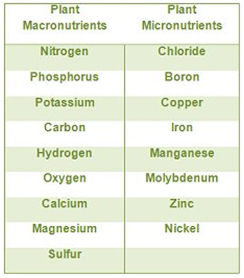Along with clean water, a nation's food supply is one of its most vital resources, providing the raw nutrition for everyday living. Unfortunately for many, especially in developing countries, food supplies fall short of demand. Worldwide, some 850 million people struggle to obtain adequate amounts of food to eat every day. The United Nations Food and Agriculture Organization forecasts that by 2050, world food production must double to feed the global population.
To ensure an abundant, healthy food supply, soil nutrients must be replenished on a regular basis. By applying fertilizers intelligently, farmers use chemistry to deliver essential nutrients back into their soils. Agricultural experts estimate that without commercial fertilizers, the world food supply would shrink by one-third. Chlorine chemistry, in particular the chemistry of chloride salts, plays a role in improving the harvest by helping to supply some of these critical nutrients. Chloride is a negatively charged form of chlorine. A common chloride salt is table salt, sodium chloride. Scientists tell us that chloride plays a role in what has been called the most important biological process on Earth—that which gives us oxygen to breathe and food to eat: photosynthesis.
Plants: They're Elemental
Plants are largely made of the chemical elements carbon, hydrogen and oxygen, all of which are extracted from water and air. In addition, plants require varying amounts of at least 17 other chemical elements, classified as either macro- or micronutrients. While much lower levels of micronutrients are needed by plants than macronutrients, both types are equally important for their growth.

Delivering Nutrients
Chloride salts may be added by farmers to fertilizer to deliver zinc, manganese, potassium and nitrogen, natural soil constituents that are depleted by normal crop growth.
- Chloride is essential to photosynthesis and helps maintain electrical charge balance as nutrients are taken up by crops. It is also essential to maintaining water levels in plant cells. Chloride diminishes the effects of fungal root diseases and common rot on small grains. Research conducted on wheat in Kansas showed that chloride fertilization increased grain yields by an average of eight bushels per acre. In humans, chloride helps regulate fluids, muscle functioning, digestion and nutrient absorption.
- Zinc is essential to pollination and seed germination, and can be applied to farmland as zinc chloride, (ZnCl2). Much of the world's soils are zinc-deficient, including about half of China's and India's agricultural soils. It is estimated that one-third of the world's population is at risk of zinc deficiency. Humans require zinc for skin health and reproductive and immune system maintenance. Zinc aids sight, taste and smell.
- Manganese is essential to photosynthesis and helps to reduce leaf and root diseases. Manganese can be applied to soils as manganese chloride (MnCl2). Manganese aids human bone formation, digestion, and the immune system.
- Potassium is the nutrient known as "the regulator" and it can be added to farmland in the form of potassium chloride (KCl). Potassium helps regulate the absorption of water through leaf pores. Potassium helps prevent heart and kidney disease and diabetes.
- Nitrogen, applied as ammonium chloride (NH4Cl), is essential to crop growth because of its presence in proteins and other critical plant substances. Nitrogen is found in the green plant pigment known as chlorophyll. The largest single crop use of nitrogen is wheat, which receives approximately 17 percent of the nitrogen fertilizer in the world (California Foundation for Agriculture in the Classroom Fact Sheet). Found in proteins, hormones and other basic substances, nitrogen is fundamental to human functioning.